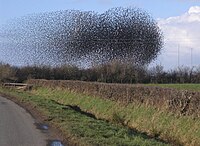
Photo from wikipedia
Improving the functionality of soft continuum manipulators to expand their application space has always been an important development direction for soft robotics. It remains very challenging to calculate the deformations… Click to show full abstract
Improving the functionality of soft continuum manipulators to expand their application space has always been an important development direction for soft robotics. It remains very challenging to calculate the deformations of soft materials and predict the basic structure of soft fingers under complex objective functions and constraints. This work develops a cable-driven soft robotic gripper with multi-input and multi-output using topology optimization considering geometric nonlinearity, which not only performs adaptive grasping but also enables finer manipulations such as rotating or panning the target. A scheme that can describe adaptive grasping behavior is proposed, which converts the contact between the clamping surface and the object into a boundary condition to circumvent complex contact nonlinearities. An additive hyperelasticity technique is used to overcome numerical instabilities, and the finite element analysis is performed in ANSYS. Numerical simulations and experimental results are performed to demonstrate the effectiveness of the optimization algorithm and to illustrate the application potential of the proposed gripper.
Journal Title: Structural and Multidisciplinary Optimization
Year Published: 2020
Link to full text (if available)
Share on Social Media: Sign Up to like & get
recommendations!